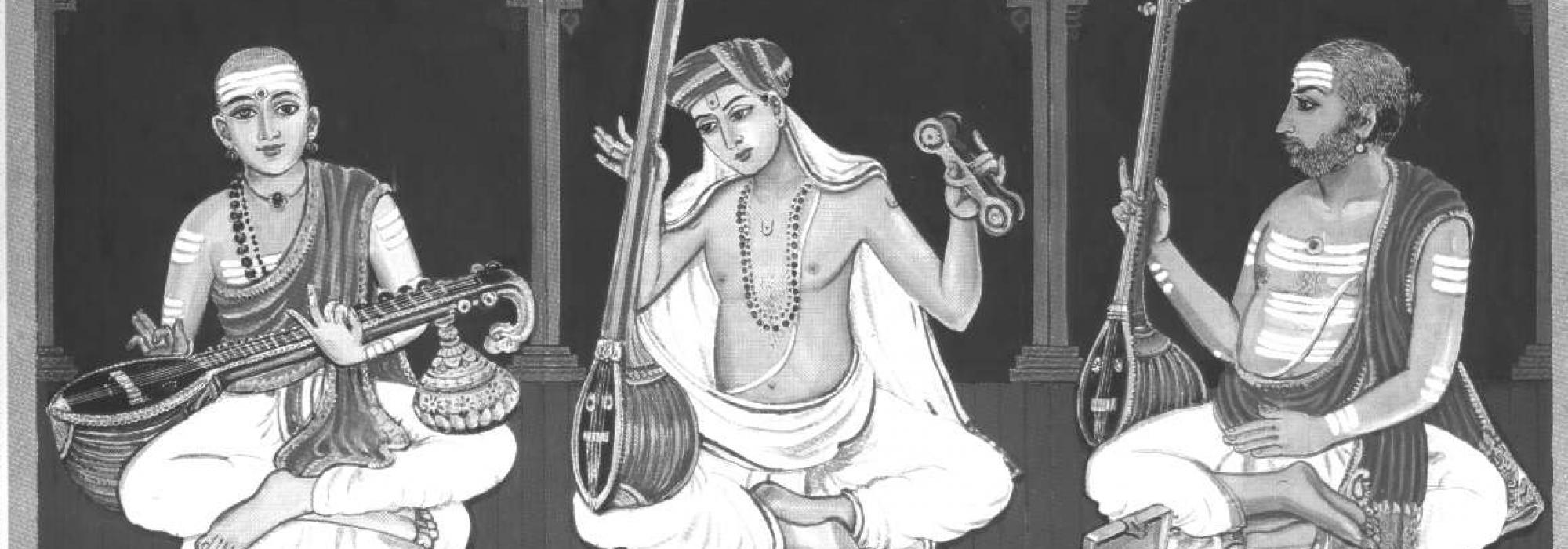Evolution of Raaga
Raagas have changed and even transformed with respect to the definition given by Bharatamuni. Of course, it is only natural for perspective of arts to change with times. The most ancient forms of music that we can trace goes back to the Vedas. We can experience the early forms in folk, tribal music as well as in some theatrical music such as in yakshagaana or sopaanam. Apart from this, musicologists like Shrangadeva, PandarikaVitthala have theorized and described in detail the lakshana(characteristics) in their works.
Many raagas of previous eras are not in use anymore. Several others have changed formsand have been embellished with new phrases etc. Many new raagas have taken shape during this time as well. But in spite of these changes many raagas have retained their form through many centuries. Many folk tunes have been incorporated into classical forms.
[contextly_sidebar id="N9M80SzgyuXh7M9MZuzNci47aqLk1vlw"]
Starting from Madhava Vidyaranya to Pandarika Vitthala and Venkatamakhin, carnatic music has been enriched. The compositions of Purandaradasa followed by the trinity of Thyagaraja, Shyama Shastri and Muttuswami Dikshitar formed the pinnacle of our musical development. Simultaneously in northern India, Gopalanaayaka, Swami Haridasa of Brindavan and Tansen contributed immensely to the development of North Indian form of music.
Experiencing Raaga
For most people, their experience of a raaga comes from listening to it, not from the technical details. An easy access to music is in our films. The various scales, raagas and modulations used in film music of yesteryears, provide a very simple but comprehensive introduction to music. Even the music of present day commercial films don’t defy basic shruti-laya-gamakas that are established in our music system. Any music which conforms to shruti-laya-gamaka and a dose of emotional expression forms good music. When all these factors fall in place, the language and the lyrics become incidental. That is why, even though we may not be able to grasp the lyrics, we would still be able to appreciate music where lyrics are set to languages we don’t understand.
In many instances of musical adaptations, lyrics become corrupted and take different forms which may not be same as original composition. An example of this could be the adaptations of Jayadeva’s Ashtapadi in the music for Odissi dance. The original lyrics of Jayadeva become difficult to identify, but the grandeur of the musical composition and the support orchestra by bansuri, create the experience in the listener. Good music can overcome lack of quality in lyrics or wrong pronunciation, but for that to happen, the rendition of music itself has to go to the level of creating the intended emotional experience (rasa) to the listener.
Many times, even though we might not know many technical details or even the name of a raaga, we get a feeling to liking it and wanting to listen to the same tune multiple times.
Raaga Hindola and film music
Let us examine music in films with Hindola as an example. Raaga Hindola has a symmetric pentatonic scale. It is used both in north indian as well south indian styles of music. In hindustani(north indian) style it is referred to as Malkauns. As per the melakartha system, Hindola is a janya(derived scale) of 20th mela natabhairavi.
The song “baagilanu teredu” from movie Bhakta Kanakadasa(released in 1960, was based on life of saint Kanakadasa. Song sung by Dr.PB Srinivas and music composition by KTS Venkatraju) is a wonderful exposition of Hindola(the song in some phrases switches to Chandrakauns, but mostly sticks to Hindola). Then we have “bhameya nodalu taa banda” form movie School-master(Song sung by Soolamangalam Rajalakshmi and music composition by TG Lingappa) contain usage of various gamakas and birkhas in rendition. In Kannada movies, “pavadisu palaksha” from movies sati shakti and ”chandramuki pranasakhi” among others are example for Hindola.
In Telugu “ramakathanu vinarayya” from movie Lava-Kusha, is a true master piece. Some the phrases used in this song, the background music, use of veena has enhanced the effect of the song. Of course the musical genius of Ghantasala Venkateshwara Rao and singing ability of singers P Susheela and P Leela are not to be left unnoticed. Again “sandehinchakuvamma” from lava-kusha is also composed in same raaga. “Rajashekara nee pai” from movie Anarkali stands as a superb exposition of Malkauns.
“Adha hai chandrama” from Navrang sung by Asha Bhonsle and MahendraKapoor, “Man tadpat” from Baiju Bawara, the heart-rendering melody from Mohammed Rafi and “aye malik” from do ankhe baara haat sung by Lata Mangeshkar are some examples of Hindola/Malkauns among 100s composed Hindi movies.
Hindola means to swing, and its beauty tempts us to continue to keep swinging with it.
Adapted from original Kannada by Vishwanath Chandrashekar
















































